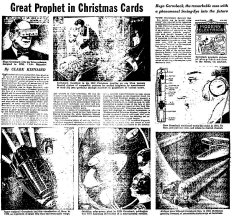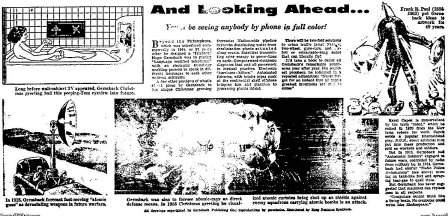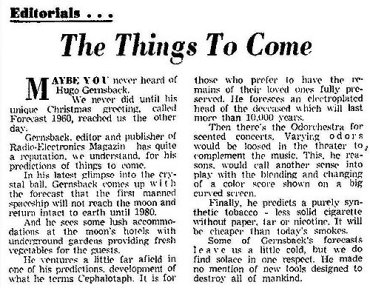
Official Edgar Rice Burroughs Tribute and Weekly Webzine Site
Since 1996 ~ Over 15,000 Webpages in Archive
Volume 1464a
EDGAR
RICE BURROUGHS / HUGO GERNSBACK
Part
of our ERB Connections Series
Pt. IV: Great Prophet In Christmas
Cards

EDGAR
RICE BURROUGHS / HUGO GERNSBACK
Part
of our ERB Connections Series
Pt. IV: Great Prophet In Christmas
Cards
|
with a phenomenal seeing-eye into the future By Clark Kinnaird ~ Pennsylvania Gettysburg Times ~ 1965.12.23   Perhaps the most unusual Christmas greeting mailed each season comes from the office in New York of a man who is as fascinating as he is widely unknown," said an editorial in a newspaper whose attention thousands of internationally important persons seek, The Washington Post. |
 |
Hugo Gernsback Forecast
1954
Pennsylvania Pottstown Mercury ~ 1953.12.28 Forecast -- For many years (the author says "in spite of all," he has been doing it since 1908) this column has received an annual Christmas card from Hugo Gernsback, New York publisher. It's always in the form of a pocket sized booklet, usually contains 32 pages, and always is a forecast for the coming year. This year, in his "Forecast 1954," Gernsback says the first atom-powered space ship will take off for the moon in 1970. In Forecast 1954, Gernsback outlines in etail the first flight to the moon in a television-guided spaceship which will be unmanned. Completely outfitted with a unique television transmitter, it will relay to earth all the sights, sounds and experiences humans might undergo on that epic flight. This first flight will be teh forerunner of manned ships of the future, he says. |
 |
Ohio Zanesville Times Recorder ~ 1959.12.18 Maybe you never heard of
Hugo Gernsback. We never did, until his unique Christmas greeting, called
Forecast 1960, reached us the other day.
In his latest glimpse into the crystal ball, Gernsback comes up with the forecast that the first manned spaceship will not reach the moon and return intact to earth until 1980. And he sees some lush accommodations at the moon's hotels with underground gardens providing fresh vegetables for the guests. He ventures a little far afield in one of his predictions, development of what he terms Cephalotaph. It is for those who prefer to have the remains of their loved ones fully preserved. He foresees an electroplated head of the deceased which will last more than 10,000 years. Then there's the Odorchestra for scented concerts. Varying odors would be loosed in the theater to complement the music. This, he reasons, would call another sense into play with the blending and changing of a color score shown on a big curved screen. Finally, he predicts a purely synthetic tobacco -- less solid cigarette without paper, tar or nicotine. It will be cheaper than today's smokes. Some of Gernsback's forecasts leave us a little cold, but we do find solace in one respect. He made no mention of new tools designed to destroy all of mankind. |
|
|
|
|
|
|
|
|
|
|
|
|
|
|
|
![]()
![]()
![]()
![]()

![]()
BILL
HILLMAN
Visit
our thousands of other sites at:
BILL
AND SUE-ON HILLMAN ECLECTIC STUDIO
ERB
Text, ERB Images and Tarzan® are ©Edgar Rice Burroughs, Inc.-
All Rights Reserved.
All
Original Work ©1996-2005/2010/2021 by Bill Hillman and/or Contributing
Authors/Owners
No
part of this web site may be reproduced without permission from the respective
owners.